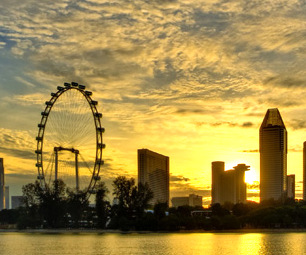The F1 cars raced at crazy speeds below. Two weekends ago, from high up in an enclosed air-conditioned capsule of the Singapore Flyer, we couldn't hear the roar of the car engines.
But it was amazing to catch glimpses of the F1 race in the brightly-lit streets below against the quiet backdrop of the city skyline.
Watch our video (69 seconds) -->
The Singapore Flyer is owned by a JV that is 90% controlled by Straco Corporation, the other 10% by Woodlands Transport Services, the largest private transport operator in Singapore.
The JV -- Straco Leisure -- acquired the Flyer at the end of 2014. It's nearly three years now.
We spoke with a Straco shareholder -- a fulltime investor -- for his take on the Flyer. Q: The Flyer has turned nicely profitable under Straco. This is contrary to many people's expectation that the Flyer would need time and capex to return to profitability and would dent Straco's profits in the meantime. Can you give us a summary of the Flyer's performance?
Q: The Flyer has turned nicely profitable under Straco. This is contrary to many people's expectation that the Flyer would need time and capex to return to profitability and would dent Straco's profits in the meantime. Can you give us a summary of the Flyer's performance?
A: Straco took over the distressed asset in Nov 2014. It turned the operation around almost immediately and the Flyer started to contribute from December 2014.
In 2015, the Flyer generated revenue of $37.7 million and pretax profit of $12.3 million, according to the annual report.
In 2016, it was $40.3m and pretax profit of $10.8m, representing a healthy pretax margin of 26%, a commonality found among all of Straco's tourist attractions.
After accounting for taxes, the Flyer contributed $8.2m in attributable profit to Straco in 2016.
For 1H17, the numbers were not disclosed. My deduction is that the figures were comparable to those of 1H16.
|
Stock price |
85 c |
|
52-wk range |
73.5–90c |
|
PE (ttm) |
14.8 |
|
Market cap |
S$731 m |
|
Shares outstanding |
859.5 m |
|
Dividend |
2.9% |
|
Year-to-date return |
11.8% |
|
Source: Bloomberg |
|
Q: What have been its annual free cash flow and depreciation?
A: Depreciation runs up to ~$8m per annum and the asset generates annual cash flow of about $17m. The regular maintenance does not cost a lot and most of the cash generated is free cash flow.
Management is using part of the cash flow to pay down debts taken for the acquisition, and is also targeting a major face uplift for the whole place which is estimated to cost $30m.
|
Q: Considering the total acquisition cost was $140 million, what return on investment does it deliver? A: Straco borrowed $84m to finance the $140m acquisition. On an equity basis, the group is generating a 16% return on its investment, which is very satisfactory. |
Q: What is the Flyer's capacity and what are the visitor numbers in comparison?
A: Annual capacity of the Flyer is more than 6 million visitors. The utilisation has been low at ~20% with visitorship flat at 1.3m for some years.
Q: Given the significant upside potential in visitorship, what can be done to boost the Flyer's profitability further?
A: There is scope to improve earnings given its prime location and large land area which includes a retail component and ample carpark space.
The key is to make the place a destination for people to go to, with varied F&B, arts and entertainment choices.
Management is targeting a revamp of the retail area, working in conjunction with various statutory boards and renowned architects. The Singapore Flyer is an iconic local attraction and stands out beautifully in Singapore's night sky. With good execution, there is potential to drive footfall higher.
Q: What is the relative contribution of the Flyer to the group which has two other key assets -- the Shanghai Ocean Aquarium and the Underwater World Xiamen?
A: The Flyer contributed $8.2m in net profit last year, approximately 18% of the total group profit of $46m.






